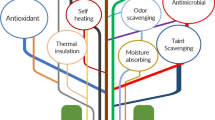Abstract
α-Tocopherol is a well-known fat-soluble antioxidant and is widely used in the food industry for stabilizing free radicals. Incorporation and stability of it into food is another challenge as directly added α-tocopherol is prone to inactivation by food constituents. This study was aimed at optimizing conditions for encapsulation of α-tocopherol using combination of sodium alginate (0.5, 1.0, 1.5 and 2.0%) as primary wall material and pectin (2.0%) as filler. The optimum conditions were selected on the basis of encapsulation efficiency, shape, size, bulk density, yield and swelling index with syringe method. The encapsulation efficiency of α-tocopherol in microencapsules produced under optimal conditions was 52.91% using sodium alginate 1.5% w/v and pectin 2.0% w/v. α-Tocopherol was encapsulated with encapsulator using standard conditions and was compared with syringe method. The encapsulation efficiency was found more (55.97%) in microencapsules prepared with encapsulator and 52.11% in microencapsules prepared with syringe.


Similar content being viewed by others
References
AOAC (2000) Official methods of analysis, 17th edn. Association of Official Analytical Chemists, Washington, DC
Bansode SS, Banarjee SK, Gaikwad DD, Jadhav SL, Thorat RM (2010) Microencapsulation: a review. Int J Pharm Sci Rev Res 1:38–43
Bowker MI, Stahl PH (2008) Preparation of water-soluble compounds through salt formation. In: Wermuth CG (ed) The practice of medicinal chemistry. Elsevier, Burlington, MA, pp 747–766
Cervantes B, Ulatowski LM (2017) Vitamin E and Alzheimer’s disease—is it time for personalized medicine? Antioxidants 6:45. https://doi.org/10.3390/antiox6030045
Chan ES, Wong SL, Lee PP, Lee JS, Ti TB, Zhang Z, Poncelet D, Ravindra P, Phan SH, Yim ZH (2011) Effects of starch filler on the physical properties of lyophilized calcium–alginate beads and the viability of encapsulated cells. Carbohydr Polym 83:225–232
Dasgupta N, Ranjan S, Mundra S, Ramalingam C, Kumar A (2016) Fabrication of food grade vitamin E nanoemulsion by low energy approach, characterization and its application. Int J Food Prop 19:700–708
Drusch S (2007) Sugar beet pectin: a novel emulsifying wall component for microencapsulation of lipophilic food ingredients by spray-drying. Food Hydrocoll 21:1223–1228
Fang Y, Al-Assaf S, Phillips GO, Nishinari K, Funami T, Williams PA (2008) Binding behaviour of calcium to polyuronates: comparison of pectin with alginate. Carbohydr Polym 72:334–341
Farias MC, Moura ML, Andrade L (2007) Encapsulation of the α-tocopherol in a glassy food model matrix. Mater Res 10:57–62
Fu S, Thacker A, Sperger D, Boni R, Buckner I, Velankar S (2011) Relevance of rheological properties of sodium alginate in solution to calcium alginate gel properties. AAPS PharmSciTech 12:1–8
Goh CH, Heng PW, Chan LW (2012) Alginates as a useful natural polymer for microencapsulation and therapeutic applications. Carbohydr Polym 88:1–12
Hogan SA, McNamee BF, Riordan O, Sullivan O (2001) Emulsification and microencapsulation property of sodium caseinate/carbohydrate blends. Int Dairy J 11:137–144
Humblet-Hua KNP, Scheltens G, van der Linden E, Sagis LMC (2011) Encapsulation systems based on ovalbumin fibrils and high methoxyl pectin. Food Hydrocoll 25:569–576
Liu LS, Fishman ML, Kost J, Hicks KB (2003) Pectin-based systems for colon-specific drug delivery via oral route. Biomaterials 24:3333–3343
Liu LS, Fishman ML, Hicks KB (2007) Pectin in controlled drug delivery—a review. Cellulose 14:15–24
Nanditha B, Prabhasankar P (2008) Antioxidants in bakery products: a review. Crit Rev Food Sci Nutr 49:1–27
Narsaiah K, Jha SN, Bhardwaj R, Sharma R, Kumar R (2011) Optical biosensors for food quality and safety assurance—a review. J Food Sci Technol 49(4):383–406
Narsaiah K, Jha SN, Wilson RA, Mandge HM, Manikantan MR (2014) Optimizing microencapsulation of nisin with sodium alginate and guar gum. J Food Sci Technol 51:4054–4405
Nochos A, Douroumis D, Bouropoulos N (2008) In vitro release of bovine serum albumin from alginate/HPMC hydrogel beads. Carbohydr Polym 74:451–457
Parthasarathi S, Anandharamakrishnan C (2016) Enhancement of oral bioavailability of vitamin E by spray-freeze drying of whey protein microcapsules. Food Bioprod Process 100:469–476
Shalaka D, Naik SR, Amruta A, Parimal K (2009) Vitamin E loaded pectin alginate microspheres for cosmetic application. J Pharmacy Res 2:1098–1102
Tsai J, Rizvi SSH (2017) Simultaneous microencapsulation of hydrophilic and lipophilic bioactives in liposomes produced by an ecofriendly supercritical fluid process. Food Res Int 99:256–262
Wong TW, Colombo G, Sonvico F (2011) Pectin matrix as oral drug delivery vehicle for colon cancer treatment. AAPS PharmSciTech 12:201–214
Yoo SH, Song YB, Chang PS, Lee HG (2006) Microencapsulation of α-tocopherol using sodium alginate and its controlled release properties. Int J Biotech Macromol 38:25–30
Yusop FHM, Manaf SFA, Hamzah F (2017) Preservation of bioactive compound via microencapsulation. Chem Eng Res Bullet 19:50–56
Zhong D, Huang X, Yang H, Cheng R (2011) New insights into viscosity abnormality of sodium alginate aqueous solution. Carbohydr Polym 81:948–952
Acknowledgements
The authors are thankful to Head, Department of Food Science and Technology, Punjab Agricultural University for providing necessary laboratory facilities. Authors are also thankful to Dr. Kairam Narsaiah for providing microencapsulator facilities in CIPHET, Ludhiana.
Author information
Authors and Affiliations
Corresponding author
Ethics declarations
Conflict of interest
The authors declare that they have no conflict of interest.
Rights and permissions
About this article
Cite this article
Singh, J., Kaur, K. & Kumar, P. Optimizing microencapsulation of α-tocopherol with pectin and sodium alginate. J Food Sci Technol 55, 3625–3631 (2018). https://doi.org/10.1007/s13197-018-3288-6
Revised:
Accepted:
Published:
Issue Date:
DOI: https://doi.org/10.1007/s13197-018-3288-6




